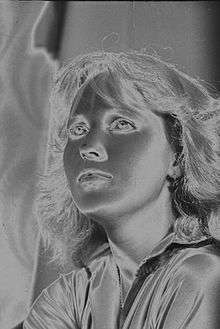Solarisation
| Alternative photography |
|---|
 |
Pseudo-solarisation (or pseudo-solarization) is a phenomenon in photography in which the image recorded on a negative or on a photographic print is wholly or partially reversed in tone. Dark areas appear light or light areas appear dark. The term is synonymous with the Sabatier effect when referring to negatives. Solarisation and pseudo-solarisation are quite distinct effects.
In short, the mechanism is due to halogen ions released within the halide grain by exposure diffusing to the grain surface in amounts sufficient to destroy the latent image.[1]
Sabatier effect
Initially, the term solarisation was used to describe the effect observed in cases of extreme overexposure of the negative in the camera. Most likely, the effect was first observed in scenery photographs including the sun (e.q. sol, sun). The sun, instead of being the whitest spot in the image, turned black or grey. Minor White's photograph of a winter scene, The Black Sun 1955,[2] was a result of the shutter of his camera freezing in the open position, resulting in partial overexposure.[3] Ansel Adams created an image titled Black Sun, Owens Valley, California (1939) by overexposure solarisation.[4][5]
The solarisation effect was already known to Daguerre and is one of the earliest known effects in photography. John William Draper was the first to call the overexposure effect solarisation. J.W.F. Herschel already observed the reversal of the image from negative to positive by extreme overexposure in 1840. L. Moser reported in 1843: "...that the light in the camera obscura produces at first the well known negative image; with continued action of the light the image turns into a positive image.... and recently I have obtained in fact on occasion a third image which is negative".[6]
The effect generated in the dark room was then called pseudo-solarisation. Spencer defines the Sabatier effect as: "Partial image reversal produced by brief exposure to white light of a partly developed silver halide image".[7] Many other ways of chemical[8] and actinic radiation "exposure" can be utilised for the partial image reversal. The use of chemicals for image reversal is also known as 'chemical fogging'.


The pseudo-solarisation effect or Sabatier effect was described in print by H. de la Blanchere in 1859 in L’Art du Photographe. It was described again in 1860 by L.M. Rutherford and C.A. Seely,[9] separately, in successive issues of The American Journal of Photography, and in the same year by Count Schouwaloff in the French publication Cosmos. French scientist Armand Sabatier published near the end of 1860 a process of obtaining direct positives, but according to the description, this process did not seem to have any connection with the Sabatier effect as no mentioning was made of any exposure of the collodion plates after development had started.[10] The phenomenon should have been christened the Blanchere Effect,[11] for it was not described by Sabatier correctly until 1862.[12][13] However, Sabatier could not find an explanation for the phenomena.[14]
The effect was usually caused by accidentally exposing an exposed plate or film to light during developing. The artist Man Ray perfected the technique which was accidentally discovered in his darkroom by fellow artist Lee Miller. It is evident from publications in the 19th century that this phenomenon was invented very many times by many photographers as it tends to occur whenever a light is switched on inadvertently in the darkroom while a film or print is being developed.[3]
In modern film photography, this effect can be emulated for artistic effect by briefly exposing the film to actinic light during chemical development. However, because of the speed of modern films, the effect is much more commonly seen in printing.
There is a further characteristic effect: a narrow band or rim of low density, called the Mackie line, is formed at the boundaries between adjacent highlight and shadow areas. If the film negative is treated, the line is light, which produces a dark line in the print; when the print itself is processed it produces a white or light line around areas of high contrast. It is therefore always possible to determine whether the negative or print has been used to produce the solarisation effect.[15] However, researchers have shown that Mackie lines are not part of the Sabatier effect itself.[3]
In scientific photography it was soon observed that when using photographic films with very high contrast (also known as lith films), the image produced by the Sabatier effect exhibited a multitude of lines of various width, representing a specific amount of exposure within a certain range. This led to the use of the Sabatier effect for obtaining first and second order equidensities for photogrametry and equidensitometry. Interpretation or measurement of an image is sometimes aided by simplification of the density pattern. By use of tone separation or equidensitometry a continuous-tone image can be converted into a single iso-density line delineating a contour of equal density.[16] This results in data reduction and enables keying (areas or lines with iso-densities to unique patterns, grey values or colours). This keying to singular grey- or colour values is known in modern image processing as using L.U.T.s. Some applications for equidensitometry are:
- Interferometry
- Photoelastic Stress Analysis, using polarised light and birefringent models of the object under test.[17]
As said above, it is very difficult to manage all parameters for yielding consistent results when using the Sabatier effect and therefore other means of obtaining equidensities have been pursued.[18]
In the darkroom

Careful choice of the amount of light used and the precise moment in development to provide the additional exposure gives rise to different outcomes. However, solarisation is very difficult to manage to yield consistent results.
As a guide, an exposure of one second to a 25 watt incandescent lamp at two metres distance at around the end of the first minute of a 2-minute development can produce acceptable results. If the exposure is made with the developing print still in the tray of developer, it is important to stop agitation at least 10 seconds prior to exposure to allow any bubbles on the surface to disperse and to ensure that the print is lying flat. Solarising colour prints is more difficult because of the more careful control of temperature and timing that is required and because most amateur processing is undertaken in a processing drum rather than a dish.
In colour photography, different coloured lights can be used to affect solarisation, but the results become even less predictable.
It is possible to solarise a negative and subsequently solarise the print made from that negative. The results of such double solarisations are rarely successful, usually producing muddy and poorly defined images.
Agfacontour Professional Film
In 1970, Agfa marketed Agfacontour Professional Film, which simplified the process of obtaining consistent results for images that looked similar to pseudo-solarised images and therefore it was widely used in equidensitometry and art.[19][20] As of 2002, Agfacontour Film was no longer being produced.[21] The Agfacontour film contained special emulsions and in combination with the Agfacontour developer, which contained chemical fogging agents, no exposure was necessary during the developing phase.[22]
In digital media
Graphs describing solarisation curves typically place input range of tones on the x axis, with black at 0 and white to the right, and the output range of tones on the y axis with black at 0 and white up. A curve then defines the input to output mapping.
Early video synthesiser technologists concerned themselves with achieving arbitrary curves not limited by film chemistry. A goal was to extend the range of solarisation effects possible to a computer specified curve. They then applied the defined solarisation curve to real time video images. A video lookup table was often used to implement this. Using this enhanced solarisation technology, still photos could also be passed through a grey scale or colour lookup table with the advantage that the effect could be previewed and progressively improved, instead of a procedure based on darkroom exposure calculations applied on a one time basis to a volatile light sensitive film or print, as described above. This was an especial advantage for creating colour solarisations with 3 primary colours.
References
- ↑ Spencer, D A (1973). The Focal Dictionary of Photographic Technologies. Focal Press. p. 574. ISBN 0-240-50747-9.
- ↑ The Black Sun 1955
- 1 2 3 Warren, Lynne (2005). Encyclopedia of twentieth-century photography. New York: Routledge. pp. 1459–1460. ISBN 1-57958-393-8.
- ↑ "Black Sun, Owens Valley, California (1939)". Archived from the original on 2015-12-22. Retrieved 2015-12-19.
- ↑ Jolly, William L. (1997). "Solarization Demystified: Historical, Artistic and Technical Aspects of the Sabatier Effect". Retrieved 19 December 2015.
- ↑ Joachim Eggers (1968). Die Grundlagen der photographischen Prozesse mit Silberhalogeniden (in German). 3. Frankfurt am Main: Akademischer Verlagsgesellschaft. p. 1218. OCLC 310490074.
- ↑ Spencer, D A (1973). The Focal Dictionary of Photographic Technologies. Focal Press. p. 539. ISBN 0-240-50747-9.
- ↑ Buffaloe, Ed. "Duo-tone Border Depletion Solarization (thiosulfate solarization)". Unblinkingeye.com. Retrieved 19 December 2015.
- ↑ American Journal of Photography and the Allied Arts and Science. New Series, New York II (1860), page 251
- ↑ Bulletin Societé Francaise de Photographie 6 (1860), page 312
- ↑ Buffaloe, Ed. "Controlling the Sabatier Effect 1. The History and Nature of the Sabatier Effect". Unblinkingeye.com. Retrieved 19 December 2015.
- ↑ Bulletin Societé Francaise de Photographie 8 (1862), page 175, 289
- ↑ Le Moniteur de la Photographie 2 (1862), pages 27, 45, 50
- ↑ Die Grundlagen der photographischen Prozesse mit Silberhalogeniden, Dr. Tomamichel ETH Zurich, Band 3, Akademischer Verlagsgesellschaft Frankfurt am Main 1968, page 1201
- ↑ The Focal Encyclopedia of Photography, Revised Desk Edition 1969, page 1415
- ↑ Applied Photography, Arnold et all, Focal Press, page 426
- ↑ Applied Photography, Arnold et all, Focal Press, page 422
- ↑ Applied Photography, Arnold et al., Focal Press, page 428
- ↑ Agfacontour Professional in Wissenschaft und Technik, C. Sauer, Agfa-Gevaert AG Druckschrift nr. 152, 1. Auflage 1974
- ↑ Agfacontour Professional in der Photographik, Agfa-Gevaert AG Druckschrift Nr. 151
- ↑ Yurow, Harvey W. "A Novel Approach to Equidensity Photographic Images". Unblinking Eye. Retrieved 28 February 2016.
- ↑ US patent 6083671A, Harvey Warren Yurow, "Photographic developer for direct production of equidensity images on a high contrast film", published 2000-07-04, assigned to Harvey Warren Yurow
- Langford, Michael. The Darkroom Handbook. New York: Dorling Kindersley Limited, 1981. p. 236–243.